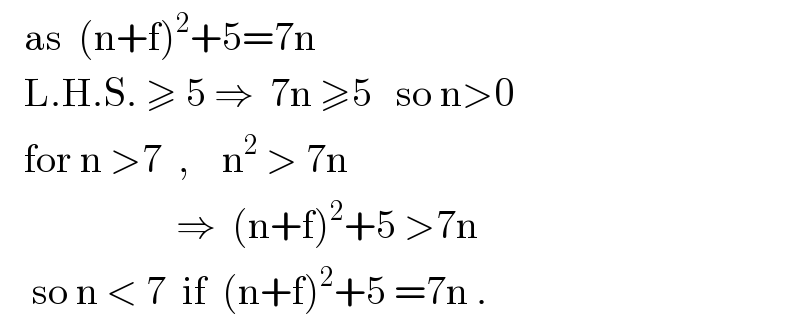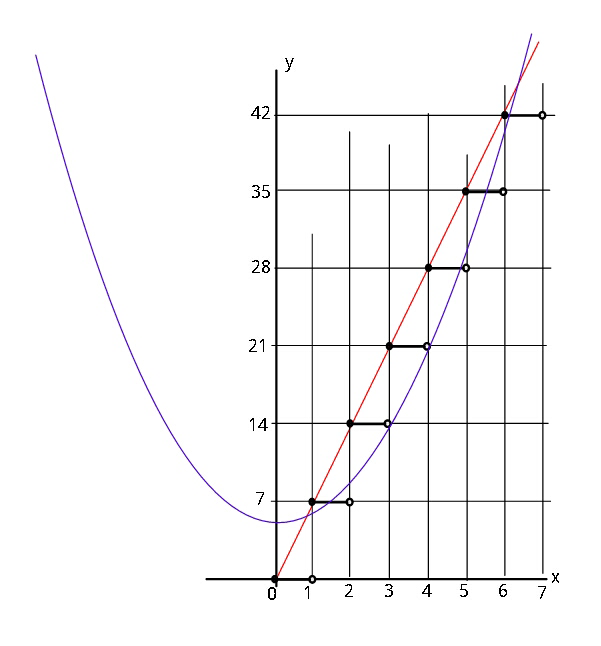Question Number 19409 by Tinkutara last updated on 10/Aug/17
![What is the sum of the squares of the roots of the equation x^2 − 7[x] + 5 = 0? (Here [x] denotes the greatest integer less than or equal to x. For example [3.4] = 3 and [−2.3] = −3.)](https://www.tinkutara.com/question/Q19409.png)
$$\mathrm{What}\:\mathrm{is}\:\mathrm{the}\:\mathrm{sum}\:\mathrm{of}\:\mathrm{the}\:\mathrm{squares}\:\mathrm{of}\:\mathrm{the} \\ $$$$\mathrm{roots}\:\mathrm{of}\:\mathrm{the}\:\mathrm{equation}\:{x}^{\mathrm{2}} \:−\:\mathrm{7}\left[{x}\right]\:+\:\mathrm{5}\:=\:\mathrm{0}? \\ $$$$\left(\mathrm{Here}\:\left[{x}\right]\:\mathrm{denotes}\:\mathrm{the}\:\mathrm{greatest}\:\mathrm{integer}\right. \\ $$$$\mathrm{less}\:\mathrm{than}\:\mathrm{or}\:\mathrm{equal}\:\mathrm{to}\:{x}.\:\mathrm{For}\:\mathrm{example} \\ $$$$\left.\left[\mathrm{3}.\mathrm{4}\right]\:=\:\mathrm{3}\:\mathrm{and}\:\left[−\mathrm{2}.\mathrm{3}\right]\:=\:−\mathrm{3}.\right) \\ $$
Commented by mrW1 last updated on 11/Aug/17

$$\mathrm{2}+\mathrm{23}+\mathrm{30}+\mathrm{37}=\mathrm{92} \\ $$$$\mathrm{is}\:\mathrm{this}\:\mathrm{right}? \\ $$
Answered by mrW1 last updated on 11/Aug/17
![f(x)=x^2 −7[x]+5 let x=f+d with 0≤d<1 ⇒f(x)=(f+d)^2 −7f+5=f^2 +(2d−7)f+(d^2 +5) f(x)≥f^2 −7f+5=g(x) f(x)<f^2 −5f+6=h(x) g(x)=f^2 −7f+5=(f−((7−(√(29)))/2))(f−((7+(√(29)))/2)) h(x)=f^2 −5f+6=(f−2)(f−3) since g(x)≤f(x)<h(x), solution of f(x)=0: ((7−(√(29)))/2)≈0.807≤f<2 or 3<f≤((7+(√(29)))/2)≈6.192 ⇒f=1,4,5,6 with x=1+d: (1+d)^2 −7×1+5=0 ⇒d=(√2)−1 ⇒x=1+(√2)−1=(√2) with x=4+d: (4+d)^2 −7×4+5=0 ⇒d=(√(23))−4 ⇒x=4+(√(23))−4=(√(23)) with x=5+d: (5+d)^2 −7×5+5=0 ⇒d=(√(30))−5 ⇒x=5+(√(30))−5=(√(30)) with x=6+d: (6+d)^2 −7×6+5=0 ⇒d=(√(37))−6 ⇒x=6+(√(37))−6=(√(37)) all solutions: (√2), (√(23)), (√(30)), (√(37)) sum of their squares: 2+23+30+37=92](https://www.tinkutara.com/question/Q19477.png)
$$\mathrm{f}\left(\mathrm{x}\right)=\mathrm{x}^{\mathrm{2}} −\mathrm{7}\left[\mathrm{x}\right]+\mathrm{5} \\ $$$$\mathrm{let}\:\mathrm{x}=\mathrm{f}+\mathrm{d}\:\mathrm{with}\:\mathrm{0}\leqslant\mathrm{d}<\mathrm{1} \\ $$$$\Rightarrow\mathrm{f}\left(\mathrm{x}\right)=\left(\mathrm{f}+\mathrm{d}\right)^{\mathrm{2}} −\mathrm{7f}+\mathrm{5}=\mathrm{f}^{\mathrm{2}} +\left(\mathrm{2d}−\mathrm{7}\right)\mathrm{f}+\left(\mathrm{d}^{\mathrm{2}} +\mathrm{5}\right) \\ $$$$\mathrm{f}\left(\mathrm{x}\right)\geqslant\mathrm{f}^{\mathrm{2}} −\mathrm{7f}+\mathrm{5}=\mathrm{g}\left(\mathrm{x}\right) \\ $$$$\mathrm{f}\left(\mathrm{x}\right)<\mathrm{f}^{\mathrm{2}} −\mathrm{5f}+\mathrm{6}=\mathrm{h}\left(\mathrm{x}\right) \\ $$$$\mathrm{g}\left(\mathrm{x}\right)=\mathrm{f}^{\mathrm{2}} −\mathrm{7f}+\mathrm{5}=\left(\mathrm{f}−\frac{\mathrm{7}−\sqrt{\mathrm{29}}}{\mathrm{2}}\right)\left(\mathrm{f}−\frac{\mathrm{7}+\sqrt{\mathrm{29}}}{\mathrm{2}}\right) \\ $$$$\mathrm{h}\left(\mathrm{x}\right)=\mathrm{f}^{\mathrm{2}} −\mathrm{5f}+\mathrm{6}=\left(\mathrm{f}−\mathrm{2}\right)\left(\mathrm{f}−\mathrm{3}\right) \\ $$$$\mathrm{since}\:\mathrm{g}\left(\mathrm{x}\right)\leqslant\mathrm{f}\left(\mathrm{x}\right)<\mathrm{h}\left(\mathrm{x}\right), \\ $$$$\mathrm{solution}\:\mathrm{of}\:\mathrm{f}\left(\mathrm{x}\right)=\mathrm{0}: \\ $$$$\frac{\mathrm{7}−\sqrt{\mathrm{29}}}{\mathrm{2}}\approx\mathrm{0}.\mathrm{807}\leqslant\mathrm{f}<\mathrm{2}\:\mathrm{or} \\ $$$$\mathrm{3}<\mathrm{f}\leqslant\frac{\mathrm{7}+\sqrt{\mathrm{29}}}{\mathrm{2}}\approx\mathrm{6}.\mathrm{192} \\ $$$$\Rightarrow\mathrm{f}=\mathrm{1},\mathrm{4},\mathrm{5},\mathrm{6} \\ $$$$ \\ $$$$\mathrm{with}\:\mathrm{x}=\mathrm{1}+\mathrm{d}: \\ $$$$\left(\mathrm{1}+\mathrm{d}\right)^{\mathrm{2}} −\mathrm{7}×\mathrm{1}+\mathrm{5}=\mathrm{0} \\ $$$$\Rightarrow\mathrm{d}=\sqrt{\mathrm{2}}−\mathrm{1} \\ $$$$\Rightarrow\mathrm{x}=\mathrm{1}+\sqrt{\mathrm{2}}−\mathrm{1}=\sqrt{\mathrm{2}} \\ $$$$\mathrm{with}\:\mathrm{x}=\mathrm{4}+\mathrm{d}: \\ $$$$\left(\mathrm{4}+\mathrm{d}\right)^{\mathrm{2}} −\mathrm{7}×\mathrm{4}+\mathrm{5}=\mathrm{0} \\ $$$$\Rightarrow\mathrm{d}=\sqrt{\mathrm{23}}−\mathrm{4} \\ $$$$\Rightarrow\mathrm{x}=\mathrm{4}+\sqrt{\mathrm{23}}−\mathrm{4}=\sqrt{\mathrm{23}} \\ $$$$\mathrm{with}\:\mathrm{x}=\mathrm{5}+\mathrm{d}: \\ $$$$\left(\mathrm{5}+\mathrm{d}\right)^{\mathrm{2}} −\mathrm{7}×\mathrm{5}+\mathrm{5}=\mathrm{0} \\ $$$$\Rightarrow\mathrm{d}=\sqrt{\mathrm{30}}−\mathrm{5} \\ $$$$\Rightarrow\mathrm{x}=\mathrm{5}+\sqrt{\mathrm{30}}−\mathrm{5}=\sqrt{\mathrm{30}} \\ $$$$\mathrm{with}\:\mathrm{x}=\mathrm{6}+\mathrm{d}: \\ $$$$\left(\mathrm{6}+\mathrm{d}\right)^{\mathrm{2}} −\mathrm{7}×\mathrm{6}+\mathrm{5}=\mathrm{0} \\ $$$$\Rightarrow\mathrm{d}=\sqrt{\mathrm{37}}−\mathrm{6} \\ $$$$\Rightarrow\mathrm{x}=\mathrm{6}+\sqrt{\mathrm{37}}−\mathrm{6}=\sqrt{\mathrm{37}} \\ $$$$ \\ $$$$\mathrm{all}\:\mathrm{solutions}: \\ $$$$\sqrt{\mathrm{2}},\:\sqrt{\mathrm{23}},\:\sqrt{\mathrm{30}},\:\sqrt{\mathrm{37}} \\ $$$$\mathrm{sum}\:\mathrm{of}\:\mathrm{their}\:\mathrm{squares}: \\ $$$$\mathrm{2}+\mathrm{23}+\mathrm{30}+\mathrm{37}=\mathrm{92} \\ $$
Commented by mrW1 last updated on 11/Aug/17

Commented by Tinkutara last updated on 12/Aug/17

$$\mathrm{Thank}\:\mathrm{you}\:\mathrm{very}\:\mathrm{much}\:\mathrm{Sir}!\:\mathrm{Awesome}! \\ $$
Answered by ajfour last updated on 12/Aug/17
![let x=n+f let x=[x]+{x}=n+f then (n+f)^2 +5−7n=0 ⇒ (n+f)^2 +5 is an integer =7n clearly 0<n<7 and 0≤f<1 x=n+f =(√(7n−5)) , f=x−n for n=1 , x=(√2) , f=(√2)−1 n=2 , x=3 , f=1 so not acceptable; n=3 , x=4 , f=1 not acceptable; n=4 , x=(√(23)) , f=(√(23))−4 this is quite alright ! n=5 , x=(√(30)) , f=(√(30))−5 and if n=6 , x=(√(37)) , f=(√(37))−6 acceptable then are n=1, 4, 5, 6 Σx^2 =Σ(7n−5) = 2+23+30+37 = 92 .](https://www.tinkutara.com/question/Q19491.png)
$$\mathrm{let}\:\mathrm{x}=\mathrm{n}+\mathrm{f} \\ $$$$\mathrm{let}\:\mathrm{x}=\left[\mathrm{x}\right]+\left\{\mathrm{x}\right\}=\mathrm{n}+\mathrm{f} \\ $$$$\mathrm{then}\:\left(\mathrm{n}+\mathrm{f}\right)^{\mathrm{2}} +\mathrm{5}−\mathrm{7n}=\mathrm{0} \\ $$$$\:\Rightarrow\:\left(\mathrm{n}+\mathrm{f}\right)^{\mathrm{2}} +\mathrm{5}\:\:\mathrm{is}\:\mathrm{an}\:\mathrm{integer}\:=\mathrm{7n} \\ $$$$\mathrm{clearly}\:\:\mathrm{0}<\mathrm{n}<\mathrm{7}\:\:\mathrm{and}\:\:\:\mathrm{0}\leqslant\mathrm{f}<\mathrm{1} \\ $$$$\:\mathrm{x}=\mathrm{n}+\mathrm{f}\:=\sqrt{\mathrm{7n}−\mathrm{5}}\:\:\:\:,\:\:\mathrm{f}=\mathrm{x}−\mathrm{n} \\ $$$$\:\:\:\mathrm{for}\:\mathrm{n}=\mathrm{1}\:,\:\:\mathrm{x}=\sqrt{\mathrm{2}}\:\:,\:\:\mathrm{f}=\sqrt{\mathrm{2}}−\mathrm{1} \\ $$$$\:\:\:\:\:\:\:\:\:\:\mathrm{n}=\mathrm{2}\:,\:\:\mathrm{x}=\mathrm{3}\:\:\:\:,\:\:\mathrm{f}=\mathrm{1}\: \\ $$$$\:\:\:\:\:\:\mathrm{so}\:\mathrm{not}\:\mathrm{acceptable}; \\ $$$$\:\:\:\:\:\:\:\:\:\:\mathrm{n}=\mathrm{3}\:,\:\:\mathrm{x}=\mathrm{4}\:\:,\:\:\:\mathrm{f}=\mathrm{1} \\ $$$$\:\:\:\:\:\mathrm{not}\:\mathrm{acceptable}; \\ $$$$\:\:\:\:\:\:\:\:\:\:\mathrm{n}=\mathrm{4}\:,\:\:\mathrm{x}=\sqrt{\mathrm{23}}\:\:,\:\mathrm{f}=\sqrt{\mathrm{23}}−\mathrm{4} \\ $$$$\:\:\:\:\:\mathrm{this}\:\mathrm{is}\:\mathrm{quite}\:\mathrm{alright}\:! \\ $$$$\:\:\:\:\:\:\:\:\:\:\mathrm{n}=\mathrm{5}\:,\:\:\mathrm{x}=\sqrt{\mathrm{30}}\:\:,\:\mathrm{f}=\sqrt{\mathrm{30}}−\mathrm{5} \\ $$$$\:\mathrm{and}\:\mathrm{if}\:\:\mathrm{n}=\mathrm{6}\:,\:\mathrm{x}=\sqrt{\mathrm{37}}\:,\:\:\mathrm{f}=\sqrt{\mathrm{37}}−\mathrm{6} \\ $$$$\:\mathrm{acceptable}\:\mathrm{then}\:\mathrm{are}\:\mathrm{n}=\mathrm{1},\:\mathrm{4},\:\mathrm{5},\:\mathrm{6} \\ $$$$\:\:\:\:\:\:\:\:\:\:\Sigma\mathrm{x}^{\mathrm{2}} =\Sigma\left(\mathrm{7n}−\mathrm{5}\right)\: \\ $$$$\:\:\:\:\:\:\:\:\:\:\:\:\:\:\:\:\:\:\:=\:\mathrm{2}+\mathrm{23}+\mathrm{30}+\mathrm{37} \\ $$$$\:\:\:\:\:\:\:\:\:\:\:\:\:\:\:\:\:\:\:=\:\mathrm{92}\:. \\ $$$$ \\ $$
Commented by ajfour last updated on 12/Aug/17

$$\:\:\:\mathrm{as}\:\:\left(\mathrm{n}+\mathrm{f}\right)^{\mathrm{2}} +\mathrm{5}=\mathrm{7n} \\ $$$$\:\:\:\mathrm{L}.\mathrm{H}.\mathrm{S}.\:\geqslant\:\mathrm{5}\:\Rightarrow\:\:\mathrm{7n}\:\geqslant\mathrm{5}\:\:\:\mathrm{so}\:\mathrm{n}>\mathrm{0} \\ $$$$\:\:\:\mathrm{for}\:\mathrm{n}\:>\mathrm{7}\:\:,\:\:\:\:\mathrm{n}^{\mathrm{2}} \:>\:\mathrm{7n} \\ $$$$\:\:\:\:\:\:\:\:\:\:\:\:\:\:\:\:\:\:\:\:\:\:\Rightarrow\:\:\left(\mathrm{n}+\mathrm{f}\right)^{\mathrm{2}} +\mathrm{5}\:>\mathrm{7n} \\ $$$$\:\:\:\:\mathrm{so}\:\mathrm{n}\:<\:\mathrm{7}\:\:\mathrm{if}\:\:\left(\mathrm{n}+\mathrm{f}\right)^{\mathrm{2}} +\mathrm{5}\:=\mathrm{7n}\:. \\ $$
Commented by Tinkutara last updated on 12/Aug/17

$$\mathrm{Thank}\:\mathrm{you}\:\mathrm{very}\:\mathrm{much}\:\mathrm{Sir}!\:\mathrm{Wonderful}! \\ $$
Commented by ajfour last updated on 12/Aug/17

Commented by ajfour last updated on 12/Aug/17
![y=7x ; y=x^2 +5 ; y=7[x]](https://www.tinkutara.com/question/Q19498.png)
$$\mathrm{y}=\mathrm{7x}\:;\:\:\:\mathrm{y}=\mathrm{x}^{\mathrm{2}} +\mathrm{5}\:;\:\:\:\mathrm{y}=\mathrm{7}\left[\mathrm{x}\right]\: \\ $$$$ \\ $$
